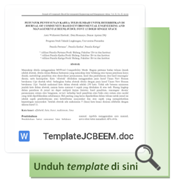ALOHA Simulation to Determine Consequence Scenarios on Transportation Liquefied Natural Gas (LNG) in DKI Jakarta Province
DOI:
https://doi.org/10.23969/jcbeem.v6i2.5924Keywords:
ALOHA, BLEVE, LNG, safe distanceAbstract
The mobility of using LNG is based on its advantages as a substituent fuel for gasoline and diesel, where LNG has low emission properties. The process of mobilizing the distribution of LNG has the potential for accidents when it takes place. The study was conducted to determine the hazards that can occur and the safe distance for evacuation in the event of a leak using ALOHA simulation. The research process is carried out by studying literature, collecting data, determining the month and time of release, and continuing with a simulation of the existing data. The data analysis technique was carried out by determining the tank temperature and water dispersion model at 31 SPBG. Fireball simulation results at 8:00 a.m. 2:00 p.m, and 10:00 p.m have safe distances at 812 meters, 812 meters, and 815 meters. Fire column simulation results at 8:00 a.m. 2:00 p.m, and 10:00 p.m have safe distances at 29 meters, 29 meters, and 28 meters. Vapor cloud simulation results at 8:00 a.m. 2:00 p.m, and 10:00 p.m have Lower Explosive Limits (LEL) at 169 meters, 160 meters, and 243 meters. Thus the ALOHA simulation can represent the safe distance of evacuation and scenarios in the event of an accident.
Downloads
References
AIChe/CCPS. (2010). Guidelines for Chemical Trasportation Risk Analysis. New York: Center for Chemical Process Safety of The American Institute of Chemical engineers.
Aryanto, R., Tuheteru, E.J., Yulia, P.S. & Patian, S. (2021). Knowledge Sharing of Occupational Health and Safety in Mining at PT. Pilar Artha Sejahtera, Lampung. Journal of Community Based Environmental Engineering and Management, 5(2): 117-124
Bhattacharya, R. & Kumar, V.G. (2015). Consequence analysis for simulation of hazardous chemicals release using ALOHA software. International Journal of ChemTech Research, 8(4): 2038-2046.
BP. (2020). Statisyical Review of World Energy 2020 69th Edition. UK.
BP Process Safety Series. (2007). LNG Fire Protection and Emergency Response. London: British Petroleum.
Dinas Tenaga Kerja Transmigrasi dan Energi. (2020, November 23). Data Stasiun Pengisian Bahan Bakar Gas (SPBG) dan Mobile Refueling Unit (MRU) di Provinsi DKI Jakarta 2020. Diambil kembali dari Jakarta Open Data: https://data.jakarta.go.id/dataset/data-spbg-dan-mru-di-provinsi-dki-jakarta
Hanna, S. R., Briggs, G. A., & Jr, R. P. (1982). Handbook on atmospheric diffusion: prepared for the Office of Health and Environmental Research, Office of Energy Research, U.S. Department of Energy. United States: Dept. of Energy. Office of Energy Research., and United States. Dept. of Energy. Office of Health and Environmental Research. Technical Information Center.
Herdzik, J. (2011). LNG As a Marine Fuel-Possibilities and Problem. Journal of KONES Powertrain and Transport, 18(2): 169-176.
Kumar, S., H, T. T., Choi, W., & Lim, J. H. (2011). LNG: An eco-friendly cryogenic fuel for sustainable development. Applied Energy, 88: 4264-4273.
Maxwell, T. T., & Jones, C. J. (1995). Conversion of Compression Ignition Engine dalam Alternative fuel: Emissions, Economics and Performance. Pennsylvania: Society of Automotive Engineers, Inc., Warrendale.
NFPA 59A. (2013). Standard for Production, Storage, and Handling of Liquified Natural Gas (LNG). USA: National Fire Protection Association.
Shao, H., & Duan, G. (2012). Risk Quantitive Calculation and ALOHA Simulation in Leak Accident of Natural Gas Power Plant, Procedia Engineering 45, 532-359.
Yang, R., Gai, K., Yang, F., Zhang, G., Sun, N., Feng, B. & Zhu, S. (2019). Simulation Analysis of Propylene Storage Tank Leakage Based on ALOHA Software. IOP Conference Series: Earth and Environmental Science, 267: 042038.














